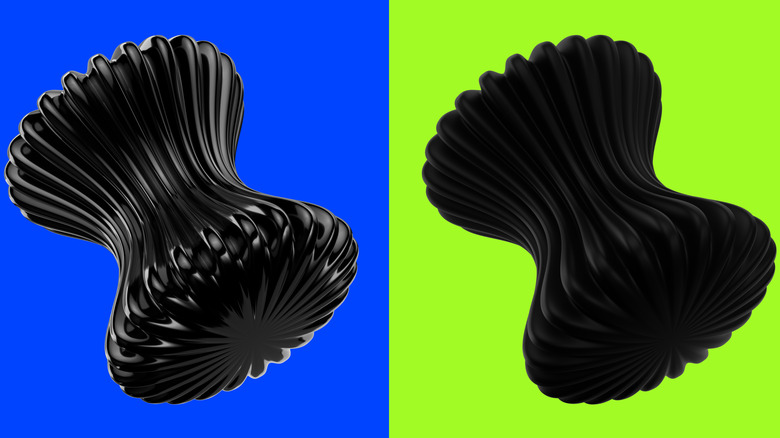The Color So Dark That Anything It Covers Looks Two-Dimensional
Few things are more frighteningly disorienting than waking up in the middle of the pitch black night, and now there's a pigment that takes that experience to even greater heights. Vantablack is a black so dark that it obscures all sense of depth. If you coated yourself entirely in Vantablack, your features would disappear, and you would look like nothing more than a silhouette.
Vantablack was invented in 2014 at the UK-based company Surrey NanoSystems. It isn't your typical paint or dye, but rather a collection of microscopic carbon nanotubes (CNTs) clustered together like a mat of grass. CNTs are hollow threads of carbon with walls that are only an atom in width. When they are clustered close enough together, they can block out light completely, creating the blackest of blacks. The name Vantablack is a reference to this technology, being a portmanteau of the acronym VANTA (vertically aligned nanotube array) and the color black. Applying Vantablack requires growing a network of CNTs on the subject you wish to cover, a process that involves secretive patented machines invented by Surrey NanoSystems. In other words, applying a coat of Vantablack is a process that can take days.
Self-taught scientist Ben Jensen founded Surrey NanoSystems to research the applications of CNTs in making semiconductors, but his team ultimately produced a material that was so black, the UK's National Physical Laboratory couldn't even measure its darkness. By reflecting less than one percent of all light, Vantablack is essentially a void.
The science behind Vantablack
The secret behind Vantablack is the same secret that lies behind our ability to see. Visible light is a type of electromagnetic wave, and the colors we see result from the way in which light rays of different wavelengths reflect off of different materials. White is the most reflective color while black is the least reflective, although from the standpoint of physics, black isn't actually a color at all because it represents the absence of visible light. The more light a material can absorb, the blacker it appears, and Vantablack does that better than anything humans had invented before.
The CNTs that make up Vantablack are clustered so tightly together that a one centimeter square patch of it would contain roughly 1 billion individual tubes. This creates an inescapable trap for visible light waves. Vantablack absorbs 99.965% of all light that touches it, impeding our depth perception by eliminating our ability to make out edges and shadows.
At the time it was unveiled, Vantablack was deemed the darkest material ever invented, but just half a decade later, in 2019, researchers at MIT unveiled a material even darker. The pigment, made from CNTs grown on pieces of aluminum foil, can absorb as much as 99.995% of all light, making it 10 times more absorbent than Vantablack. Both pigments have been shrouded in mystery due to their unprecedented nature and potential value, and to this day, only a select few have had access to the blackest of blacks.
What is Vantablack used for?
Creating the darkest substance ever is undeniably a cool thing to accomplish, but what exactly is the point of it all? For both Surrey NanoSystems and MIT, telescope design has been the primary point of focus. Telescopes are highly sensitive to surrounding light because any degree of glare can obscure the image. Coating a telescope in Vantablack allows it to absorb glare from its surroundings, leading to a much clearer image.
The world's darkest pigment also holds thrilling potential for visual artists, but Surrey NanoSystems hasn't made its product commercially available. Instead, the company licensed the use of Vantablack to British-Indian sculptor Anish Kapoor ... and nobody else. Artists from around the world voiced objections to the idea that a single creator should be allowed to hold a monopoly over an artistic material. One artist, Stuart Semple, retaliated by creating his own extreme hue, deemed "Pinkest Pink," and made it available to all artists except for Anish Kapoor.
Vantablack has also drawn the attention of the automotive world, and in 2019, Surrey NanoSystems licensed its use to BMW, which created a special model, the BMW X6, coated in a sprayable version of Vantablack. The car was an exhibition piece, and as of the writing of this article, Vantablack is not available as a commercial coating. However, aesthetics weren't the only point of this project. Coating the car in the blackest black allowed BMW designers to see how safety system sensors perform under extreme light conditions.


